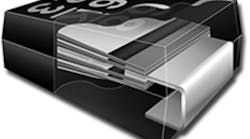This file type includes high resolution graphics and schematics when applicable.
Dielectric absorption (DA) is a condition where residual charge remains stored in a capacitor even after it has been discharged. This could lead to voltage errors in sensitive circuits, such as sample/hold (S/H) circuits, which depend upon the voltage of the capacitor remaining static between measurements. A four-page application note from AVX, “Dielectric Absorption Of Multilayer Organic (MLO™) Capacitors,” discusses dielectric absorption of various dielectric materials while highlighting the MLO capacitors’ low dielectric absorption.
Dielectric absorption is measured as a percentage of the recovered voltage after discharge over the maximum of the original voltage applied. Dielectric materials with lower permittivity constants (k) tend to exhibit lower DA than higher k dielectric materials. DA can range from 0.001% to 10%. Different dielectric materials also have different DA properties. This leads to additional design consideration for S/H circuits, as the recovered voltage could lead to error on the voltage output of the circuit.
The test performed on an MLO capacitor was based on measurement standard MIL-C 19778 using a 2-x-2-in. laminate core for the device. After charging the MLO capacitor for 1 hour at +250 VDC, the device was discharged with a 50-Ω resistor. The voltage across the device was measured 15 minutes after complete discharge. Comparing several dielectric materials, including multilayer glass and ceramic disc dielectric materials with a DA of 0.05%, the MLO capacitor measured a much lower DA of 0.0015%. (Additional information on the test performed, along with a circuit diagram, is available here.)
Other benefits of MLO technology include low-loss performance over wide frequency ranges, repeatable fabrication via a non-fired fabrication process, construction as thin as 0.45 mm, and the capability to create heat pipes with viaholes. It also boasts matched coefficient of expansion to FR-4 circuit boards, multiple RF dielectric layers (which allow for shielded internal electrodes/traces), routing/bonding pads for surface-mount-technology (SMT) components, and moisture uptake typically under 0.04%. These benefits could be considered advantages over traditional ceramic and low-temperature co-fired-ceramic (LTCC) processes.
AVX Corp., 1 AVX Blvd., Fountain Inn, SC 29644; (864) 967-2150.
This file type includes high resolution graphics and schematics when applicable.

